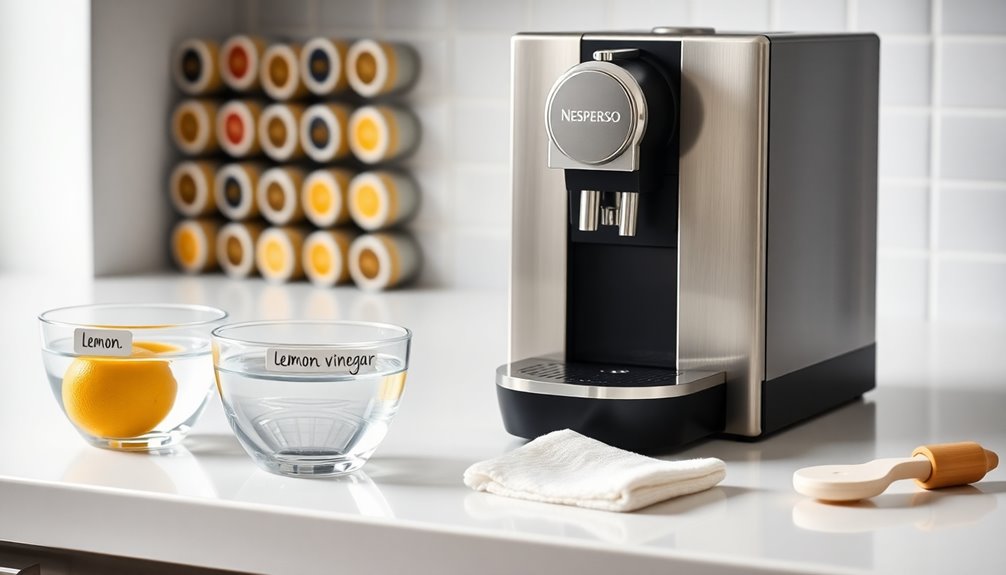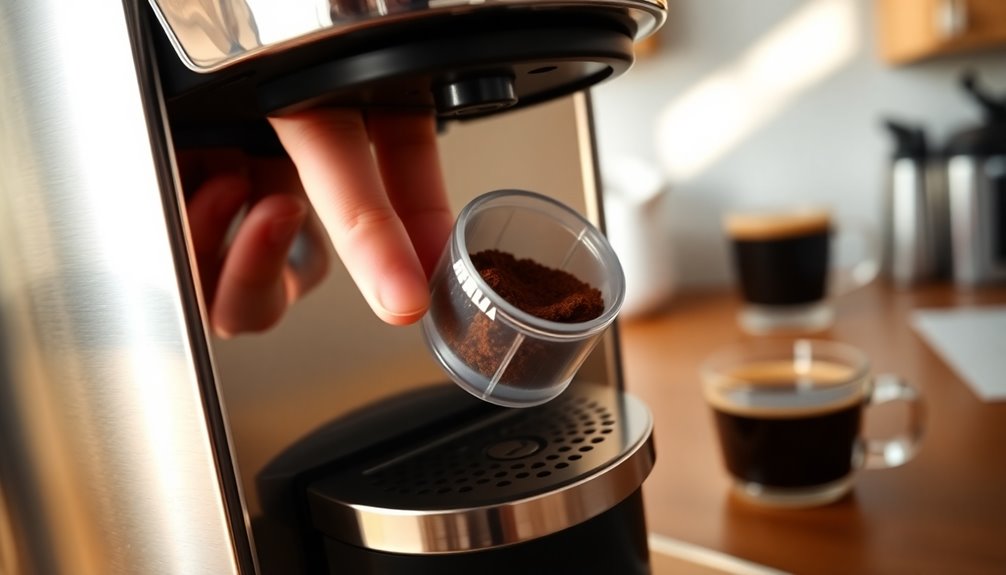To clean your Nespresso machine, start by removing all accessories, like the water tank and drip tray. Next, wash these parts with warm, soapy water. For descaling, use a Nespresso descaling solution and follow the on-screen prompts. Turn on your machine, hold the lever for two seconds, and enter descaling mode. Don't forget to place a container under the outlet. Regularly empty the used capsule container and run a cleaning cycle as needed. With these steps, you'll keep your machine in top shape. Keep going, and you'll uncover even more useful cleaning tips!
Key Takeaways
- Remove all accessories such as the water tank, drip tray, and capsule container before cleaning.
- Clean removable parts with warm, soapy water, ensuring thorough rinsing and drying.
- Descale the machine every 3 months using a descaling solution to prevent mineral buildup.
- Activate descaling mode by holding the button and lever for 3 seconds after adding the solution.
- Regularly maintain the machine by emptying the used capsule container and wiping the exterior.
Preparation and Disassembly
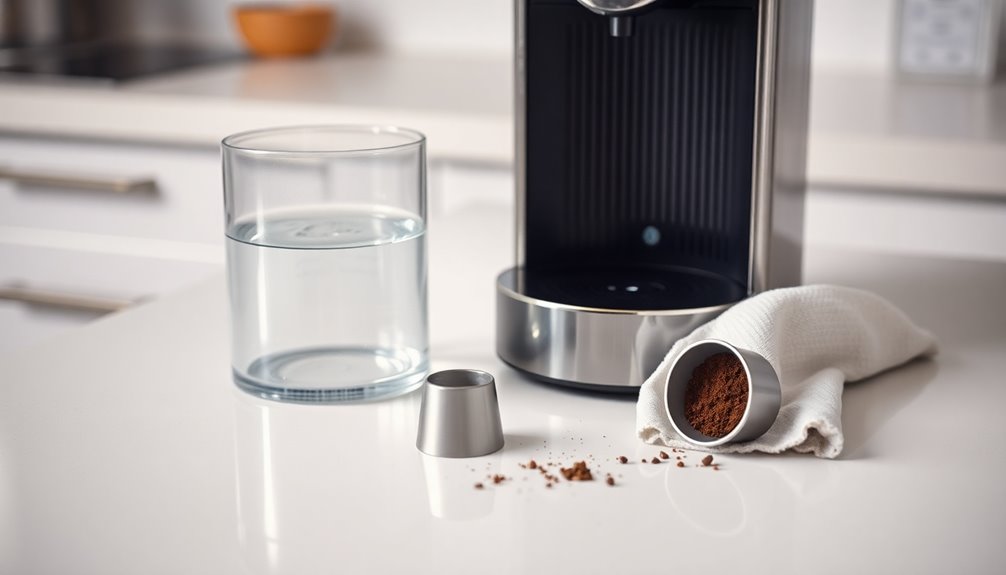
Before you plunge into cleaning your Nespresso machine, it's essential to prepare properly.
Start by removing all accessories and containers. Take out your mugs, the water tank, empty the used capsule container, and don't forget to empty the drip tray of any residual water.
Next, gather your cleaning materials: a soft dish cloth or microfiber cloth, mild dish soap, and optional white vinegar or lemon juice. Regular cleaning is essential for maintaining the machine's longevity and preventing clogs from oils and hard water.
If you notice the indicator light has switched from green to orange, it's time for descaling. For Breville models, track the cleaning schedule manually.
Finally, mix half vinegar with half water for a cleaning solution or use warm soapy water for general cleaning.
You're all set to begin!
Cleaning Removable Parts
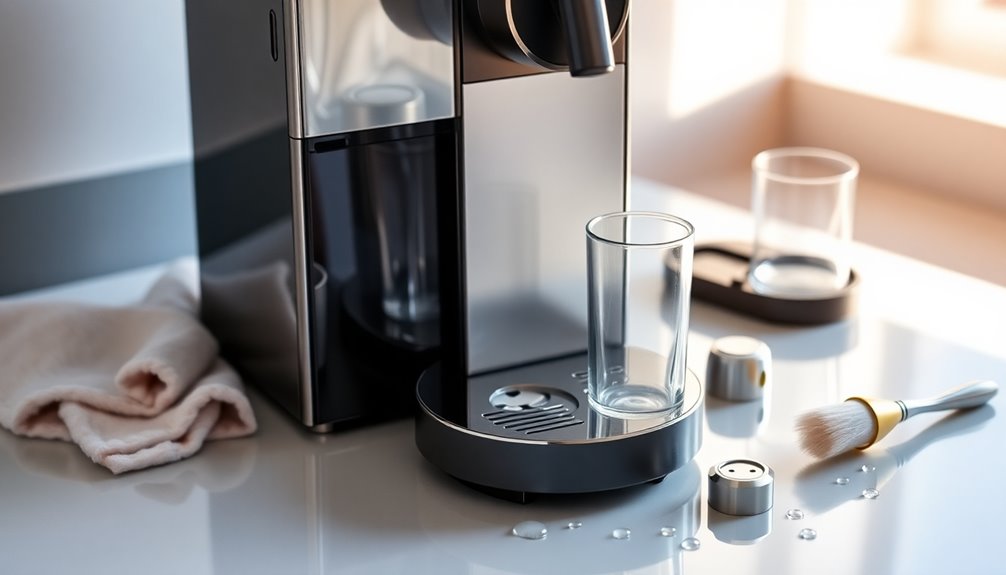
With your Nespresso machine disassembled and ready for cleaning, it's time to focus on the removable parts that can harbor coffee residues and bacteria.
Start by removing the water tank and washing it with warm water and mild dish soap. Rinse thoroughly and let it air dry completely. Using filtered water can help minimize limescale buildup in the water tank.
Next, take out the drip tray and grid, washing them in the same way. If there's stubborn residue, soak the tray before rinsing and drying.
Don't forget the capsule container and lid; clean them with warm, soapy water, ensuring all residues are removed.
Finally, wash any additional accessories like the cup support. Rinse, dry them with a microfibre cloth, and make sure everything is completely dry before reassembling.
Descaling Process
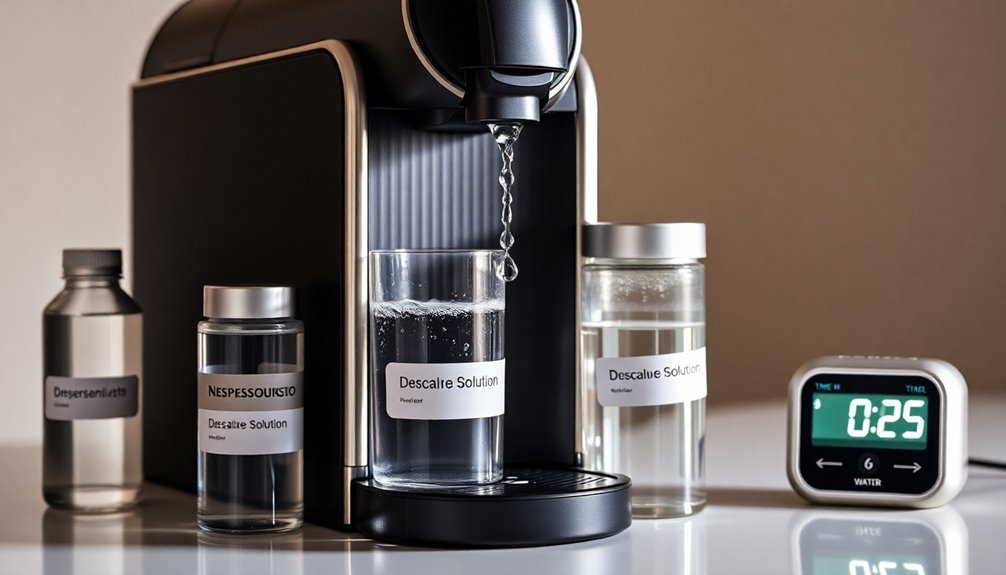
Descaling your Nespresso machine is essential for maintaining peak performance and prolonging its lifespan. Start by turning the machine on—hold the lever down for 2 seconds. Verify the capsule compartment is empty, then turn the machine off by holding the lever down for 4 seconds. Close the machine head and lock the lever to the left to power it on again. Next, use a Nespresso descaling solution and pour one pouch into the water compartment, adding at least 5 liters (17 ounces) of water. Enter descaling mode by holding the button and lever down for 3 seconds, then press the lever once. Place a large container under the outlet and press the button to begin. It is recommended to descale your machine every 3 months or after 300 capsules to ensure optimal performance. Discard the solution once finished and rinse the water tank thoroughly.
Descaling Cycle and Alerts

After completing the descaling process, you'll notice that your Nespresso machine has built-in alerts to keep you informed about when it needs maintenance.
An orange light will illuminate when it's time for immediate descaling, and the alert will blink in ready mode to remind you. Until you finish descaling, the machine will be blocked from use.
These alerts are usually found on the front panel or the back of the machine. Ignoring them can lead to decreased performance and affect the flavor of your coffee. Regular descaling is crucial because it helps to prevent mineral buildup that can hinder the efficiency of your machine.
To stay ahead, you can activate descaling reminders through your Nespresso account online, ensuring regular maintenance and ideal brewing conditions.
Regular descaling every couple of months is essential for your machine's longevity.
Rinse Cycle and Cleanup
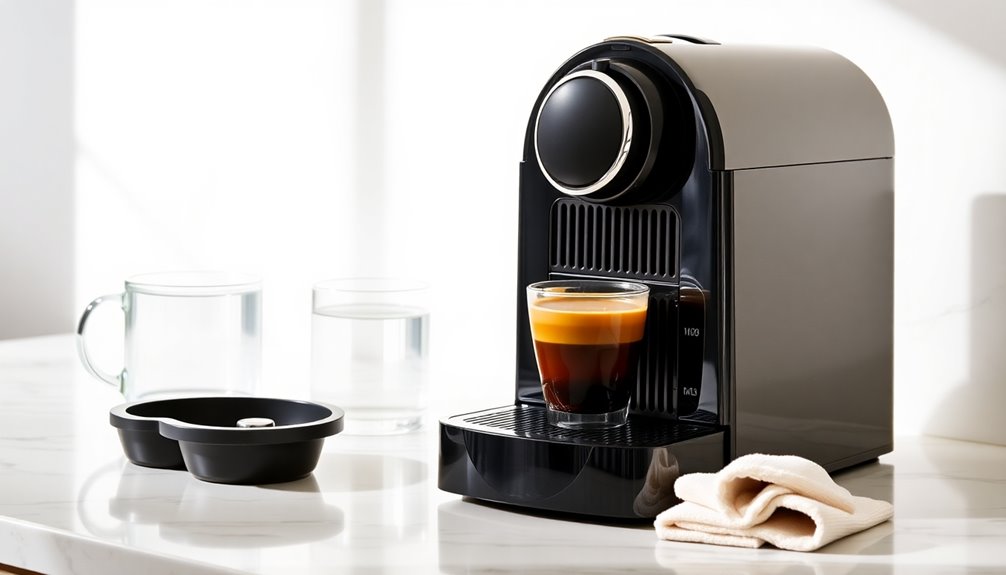
To keep your Nespresso machine in top shape, performing a rinse cycle is crucial. Start by filling the water reservoir with about 4 cups of purified water. Power on the machine and wait for the green light. Open and close the capsule container lid, then press the button three times quickly to activate the rinse cycle. Regular maintenance, such as weekly cleaning, ensures optimal performance and extends the lifespan of your machine. Place a large container under the spout to collect the water, as the machine will pump water for up to 5 minutes. Once the cycle completes, the orange light will turn solid green. Discard the collected water, refill the reservoir with fresh drinking water, and clean any components like the drip tray. Regularly performing this maintenance guarantees great coffee and machine longevity.
Reassembly Procedures
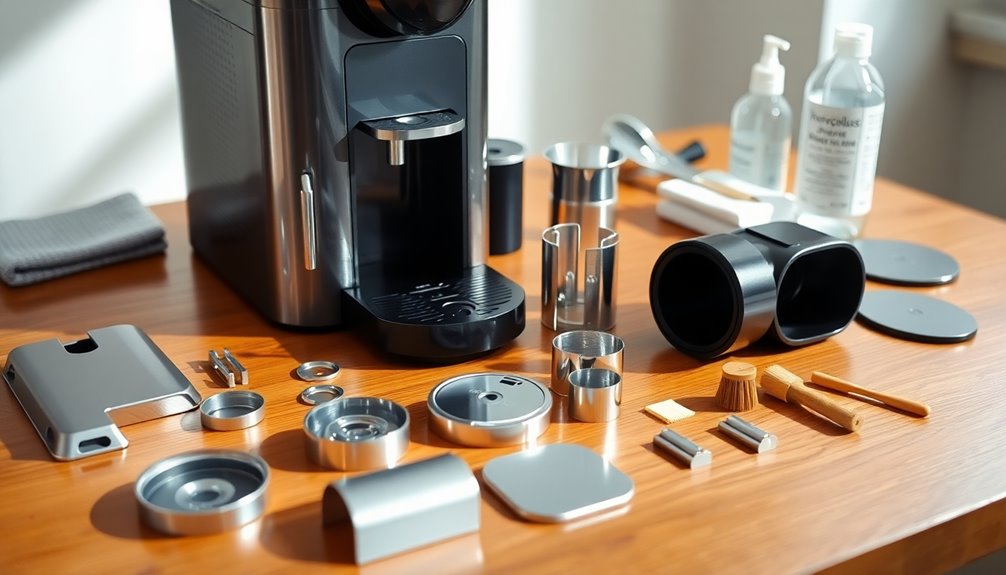
Once you’ve completed the rinse cycle and cleaned the components of your Nespresso machine, it’s time to reassemble everything. You should carefully put the components back together, making sure everything is securely in place. Once reassembled, it’s a good idea to run a few cycles of water through the machine to ensure everything is working properly. If you experience any Nespresso machine issues after reassembling, it may be necessary to consult the user manual or contact customer service for assistance.
Start by reattaching the brewing mechanism; align it and secure it with screws. Next, reconnect the electrical components. Use a small flathead screwdriver to secure the power cord retainer, then reattach the ground, live, and neutral wires. Make sure everything is snug and tucked away to prevent damage.
Now, close the cup-holder firmly before reattaching the outer covers. Align them correctly and push until you hear a click. This model is known for its energy efficiency, which contributes to its popularity amongst coffee enthusiasts.
For models like the Pixie, use a T15 torque bit to tighten screws. Finally, double-check that all clips are fastened and every part is properly aligned for peak performance.
Maintenance Tips

Maintaining your Nespresso machine is essential for ensuring a consistently great coffee experience. Start by emptying the used capsule container and drip tray after each use. Fill the water tank with fresh warm water and run a cleaning cycle with a Nespresso cleaning capsule. Regular upkeep can extend the lifespan of the machine, making it even more worthwhile to invest time in maintenance. Wipe down the exterior with a damp cloth and use a microfiber cloth with lemon juice or vinegar for the water reservoir and capsule container. Rinse the drip tray with warm, soapy water. For ideal performance, perform descaling every 6-12 months. Preheat the machine by brewing water without a capsule and store it in a dry, sunless spot. Finally, promptly replace any worn-out parts to maintain efficiency.
Recommended Cleaning Frequency
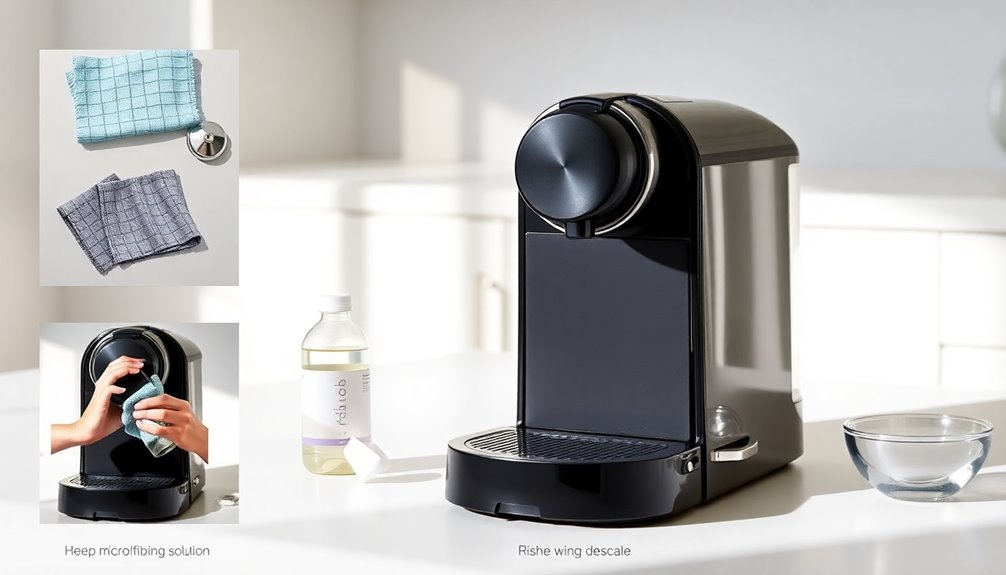
Regular maintenance of your Nespresso machine naturally leads to the importance of a proper cleaning schedule. If you use your machine daily, aim for a thorough clean every two months.
For everyone else, check the indicator light: when it changes color, it's time to clean. Breville models don't have this feature, so track your cleaning manually. Regular cleaning prevents unpleasant odors and maintains coffee taste.
Weekly, empty and wash the drip tray and capsule container. Monthly, clean the water reservoir to remove mineral deposits.
Descale every three months or after 300 capsules, especially in hard water areas. For machines lacking alerts, keep a close eye on your usage.
Regularly wipe down components to prevent build-up and maintain your machine's performance.
Frequently Asked Questions
Can I Use Vinegar Instead of Nespresso Descaling Solution?
You shouldn't use vinegar instead of a Nespresso descaling solution.
While vinegar might seem like a natural alternative, it's not effective for removing stubborn limescale and can even damage your machine's components.
The acidity can corrode rubber seals and leave a lingering smell and taste that affects your coffee's flavor.
Instead, opt for a lactic or citric acid-based descaling solution specifically designed for coffee machines to guarantee safe and thorough cleaning.
How Do I Know When My Machine Needs Descaling?
You can tell your machine needs descaling by watching for specific indicators.
If the espresso button turns half green and half orange or if you see an orange light on the Lattissima, it's a sign.
Additionally, if your machine locks after 30 cycles without descaling, that's a clear alert.
Regularly check your water hardness, as hard water can lead to more frequent descaling needs for ideal performance and taste.
What Should I Do if the Machine Won't Start?
If your machine won't start, first check the power cord for damage and verify it's plugged in securely.
Inspect the outlet with another device to confirm it's working. Look for any blown fuses and check for loose wires or a tripped circuit breaker.
If everything seems fine, verify the machine's turned on and the power button's functioning.
If issues persist, consult your user manual or reach out to customer support for help.
Is It Safe to Wash Parts in a Dishwasher?
It's generally not safe to wash most Nespresso machine parts in a dishwasher.
Most removable components aren't dishwasher safe and can warp or get damaged due to the heat.
It's better to hand wash them using mild soap and warm water.
If you have specific models, check your manual, as some parts may be top-rack dishwasher safe.
Always follow the manufacturer's guidelines to keep your machine in good shape.
Can I Clean the Machine Without Disassembling It?
Yes, you can clean the machine without fully disassembling it.
Start by wiping down the exterior with a damp cloth and a gentle cleaner.
You can also rinse the water reservoir and clean the drip tray without taking everything apart.
For internal components, run a cleaning cycle with water and a descaling solution.
Just make sure to follow the manufacturer's guidelines to avoid any damage or voiding your warranty.
Conclusion
By following this step-by-step guide, you can keep your Nespresso machine in top shape. Regular cleaning and descaling not only enhance the taste of your coffee but also extend the life of your machine. Remember to clean removable parts and perform the descaling process as needed. With a little effort and attention, your Nespresso will serve you delicious coffee for years to come. So, get started and enjoy that perfect cup!
